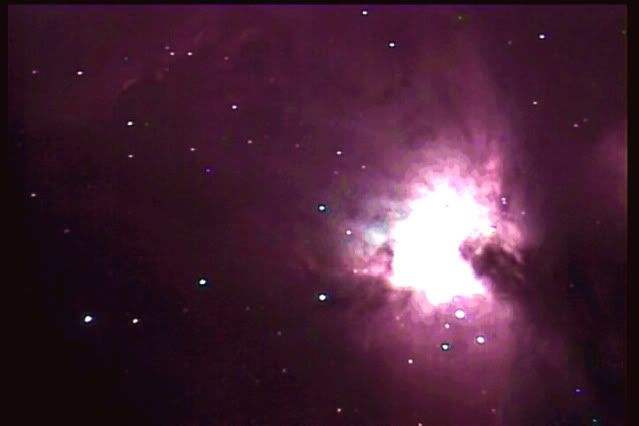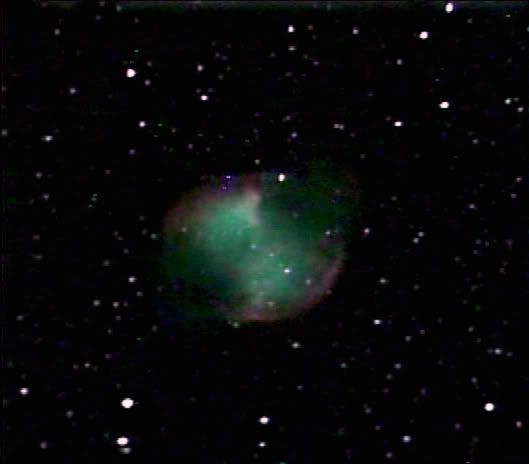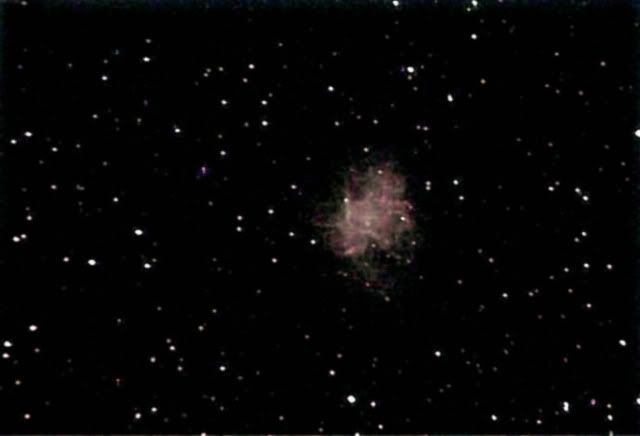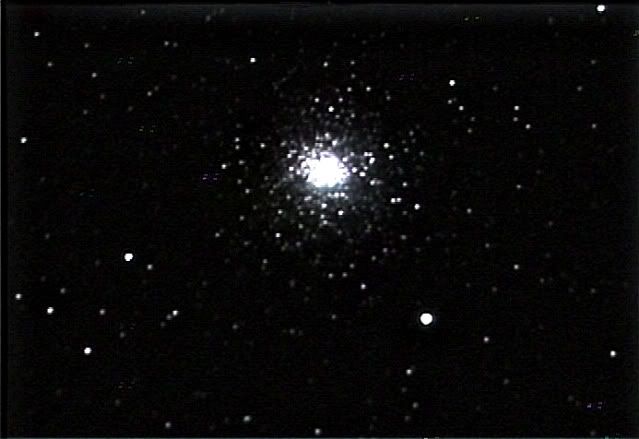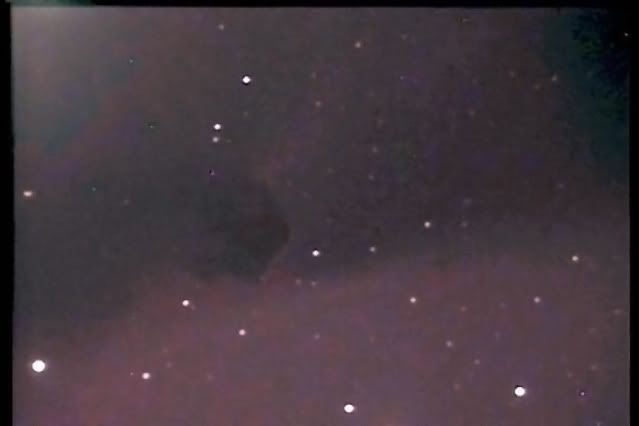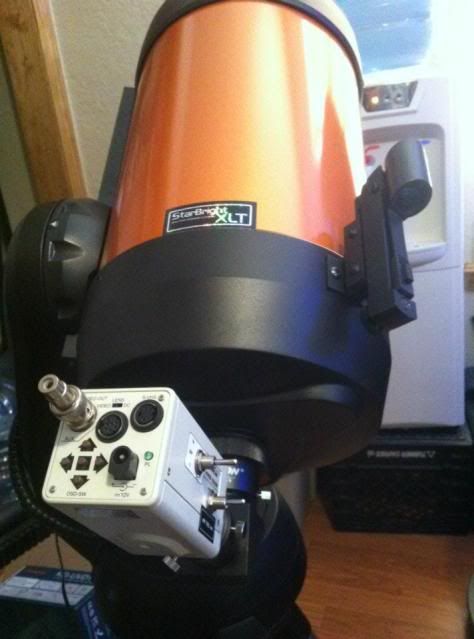Not overly impressed with this image, but it had a lot of things working against it. Wind really picked up after sunset, seeing was poor, and I think my focus was a bit on the soft side. Nevertheless, after about 6 .avi sequences, this was the best that I could come up with . Another thing that struck me as odd about this image was the lack of barges or ovals. The banding was very apparent, but no other features. Out of curiosity, I checked Christopher Go's site and looked at his image for that day. The boring side of Jupiter is just that this date, as all the brown barges are on the side with the ovals and GRS. Oh well..
Friday, December 30, 2011
Wednesday, December 28, 2011
Found some online tutorials for post processing runs of deep sky objects..
Thanks to user name Tel on the Cloudy Nights forums, I am learning tons about curve/level manipulation and why histograms are important. This is my original image of m42 tweaked with PS and the new info I just learned.
For anyone wanting to try it, here is the link..
http://www.waid-observatory.com/article-curves.html
For anyone wanting to try it, here is the link..
http://www.waid-observatory.com/article-curves.html
Some images from last 2 weeks..
If anyone says that astrophotography with a NexStar 8 is impossible, please refer them here. I was not expecting miracles, but I was not prepared for what I did get. All images taken with a stock NexStar 8SE altazimuth mounted scope. Mallincam integrations set between 2 and 14 seconds, depending on target. Enjoy!
Ring Nebula in Lyra, M57
Great Orion Nebula, M42
Dumbbell nebula in Vulpecula, M27
The Crab nebula, supernova remnant in Taurus. M1
Globular cluster in Pegasus. M15
And finally, the image I am most proud of thus far. It is not the most impressive image in this batch, but it represents one of the hardest deep sky objects for even the most seasoned astro-imagers. It is the Horsehead Nebula in Orion. This was taken with the 8" SCT in alt-az mode with only a 14 second exposure. As with all the above images, it is tweaked in photoshop to bring out the hidden details, but no info is added to this image. I did this mainly as a proof-of-concept that an acceptable image of the horsehead could be captured with a meager 8 inch scope in altaz mode with only 14 seconds. This is a visible light image, no hyrogen alpha filtering at all. Only filter in optic chain was a celestron UHC light pollution filter.
These are my first deep sky images with this telescope and I am very proud of them. As my skills grow, there will naturally be improvement in both my capture and post processing techniques. Thanks for looking!
Ring Nebula in Lyra, M57
Great Orion Nebula, M42
The Crab nebula, supernova remnant in Taurus. M1
Globular cluster in Pegasus. M15
And finally, the image I am most proud of thus far. It is not the most impressive image in this batch, but it represents one of the hardest deep sky objects for even the most seasoned astro-imagers. It is the Horsehead Nebula in Orion. This was taken with the 8" SCT in alt-az mode with only a 14 second exposure. As with all the above images, it is tweaked in photoshop to bring out the hidden details, but no info is added to this image. I did this mainly as a proof-of-concept that an acceptable image of the horsehead could be captured with a meager 8 inch scope in altaz mode with only 14 seconds. This is a visible light image, no hyrogen alpha filtering at all. Only filter in optic chain was a celestron UHC light pollution filter.
These are my first deep sky images with this telescope and I am very proud of them. As my skills grow, there will naturally be improvement in both my capture and post processing techniques. Thanks for looking!
Starship of choice Pt. 2, imaging gear...
As mentioned in an earlier post, my primary area of imaging interest was originally in lunar and planetary imaging, since I accepted the fact that with an altaz mount that deeps sky targets would not be an option. Not that there is anything at all wrong with lunar/planetary imaging, as my friend Richard said once "Deep sky objects looked the same yesterday and will look the same tomorrow". Very true and there is not any target that features so dynamically changing details as the planet Jupiter. I experimented with the webcam that came bundled with the Meade refractor, pushed it to it's limit, and decided it was not cut out for even planetary imaging. I started doing my research on imaging systems, and it became apparent that you basically had to choose between deep sky imaging and lunar/planetary imaging. There really were not many options that were suited for both. In the meantime I still had a desire to try to image at least the brighter deep sky objects despite the limitations of my scope mount.
After some research, I found that generally people were not getting very good results with deep sky imaging and my model telescope. I then stumbled across an imaging system known as the Mallincam camera. These cameras are hand built by Canadian astronomer Rock Mallin. They rely on frame integration (long exposures via video) to build an image, and as a result you end up with long exposure-like images in near "real time". These systems are custom designed for astronomical use, with extended exposure and built-in peltier cooling systems to cool the CCD chip and reduce noise in the output. I purchased a Mallincam Hyper Color camera at an amazing bargain from a fellow astronomer (Thanks Richard!) and I was in business. What makes the Mallincam so amazing is that it uses a modified 1/2" CCD with larger, more light sensitive pixels that is capable of .0000006 lux performance. It has amazing light sensitivity but as is often said, there is no free lunch in astronomy. The price to pay for this performance is lower resolution and system noise. Not a bad tradeoff, and with some luck and processing you can do some amazing shots.
Here is the Mallincam Color Hyper imager:
So with this system I will be able to push the little 8" SCT as much as it can go. It is often said that the introduction of the Mallincam imaging system will make your scope perform as if it had 4 more inches of aperture, and I can certainly see why people say that. My particular Mallincam has a max exposure time of 14 seconds, so it is kindof limiting, but honestly it is perfect for my scope as any longer and the faults of my altaz mount become apparent (field rotation, star trailing, irregular shaped stars). I will post up some of my best images obtained so far in the next post.
After some research, I found that generally people were not getting very good results with deep sky imaging and my model telescope. I then stumbled across an imaging system known as the Mallincam camera. These cameras are hand built by Canadian astronomer Rock Mallin. They rely on frame integration (long exposures via video) to build an image, and as a result you end up with long exposure-like images in near "real time". These systems are custom designed for astronomical use, with extended exposure and built-in peltier cooling systems to cool the CCD chip and reduce noise in the output. I purchased a Mallincam Hyper Color camera at an amazing bargain from a fellow astronomer (Thanks Richard!) and I was in business. What makes the Mallincam so amazing is that it uses a modified 1/2" CCD with larger, more light sensitive pixels that is capable of .0000006 lux performance. It has amazing light sensitivity but as is often said, there is no free lunch in astronomy. The price to pay for this performance is lower resolution and system noise. Not a bad tradeoff, and with some luck and processing you can do some amazing shots.
Here is the Mallincam Color Hyper imager:
My Starship of choice...Pt. 1: Telescope selection
A friend, Michael J, had given me a priceless gift. He probably didn't know he was doing it, and since astronomy has now taken center stage in my hobbies and pocketbook, he might question ever giving it to me. What did he give me? A cheap, wobbly, department store 70mm achromatic refractor and webcam branded by Meade (although I seriously doubt Meade Instruments manufactures this scope). You see, I have been hooked on astronomy before, and circumstances in the past caused me to sell my prized 10" dobsonian scope. I bought in preparation for the great 2003 Mars apparition, and it did not disappoint. Seeing the polar ice cap and dark features hooked me for life. Views of Jupiter were similar and I was amazed at how much more detail I could eek out compared to the Meade ETX-90 I had around 1996.
After receiving the 70mm achromat from my friend, I was not expecting much. Color wash is common at the edges of bright objects in achromatic refractors, so I pretty much expected to be limited to the moon. It did provide satisfactory views of the moon with the telltale chromatic abberation. On a lark I swung the scope over to Jupiter, popped in the 9mm MA eyepiece (which worsened the chromatic abberation) and took a look. To my surprise I saw clearly the north and south equatorial belts as well as a few dark brown spots or barges. Unfortunately the GRS was not visible, either by limiting magnification or being on the other side of the plantet. That did it, I once again was hooked on astronomy.
I ended up trading a DSLR camera for an Orion XT-8 dobsonian from a co-worker. The scope was like new and still held perfect collimation, or mirror alignment. I took it out several times and was duly impressed by the views. That being said, since I now had the urge to share images from the eyepiece, I found that trying to image from the eyepiece of a non-tracking scope (scope with motor drive to compensate for sidereal movement) was very frustrating. It was maddening at high magnification.
It didn't take long before I knew that I had to have a scope capable of tracking. I, at the time, only planned on doing lunar and planetary imaging, as long exposures were not necessary with those targets and I could get away with a motor-driven altitude/azimuth mount. The altaz mounts are not designed with astrophotography in mind and are generally cheaper. They are designed for visual tracking only, and do not require polar alignment or periodic error correction. As such these mounts are much cheaper, however during long exposure photography they are only capable of a max exposure of about 20 seconds before star motion (field rotation or periodic error both) become apparent in the photo. Being close to christmas, sales were everywhere and I eventually settled on a Celestron NexStar 8SE 8" computerized Schmidt-Cassegrain design telescope. The scope came with a hand controller that allows for selection of thousands of night sky objects. After alignment, the scope will slew to the selection and automatically track it for you.
I will save an in depth review for later, but suffice it to say I am beyond pleased with the performance of this telescope. Despite not having a good planetary imager, it does it's job by keeping targets properly aligned and tracked within the eyepiece. The goto function has allowed me to see more in one night that all previous years of hunting and star hopping...and without the need of a star chart. It is not only convenient, it lets me maximize my time under the stars. A big plus, especially at 20 degrees F.
Next post will deal with my imaging chain, and how I get killer astrophotos by cheating the equatorial mount/long exposure rule. You can do some amazing deep sky stuff with the celestron 8" sct on an altaz mount and I can prove it. At any rate, here is my "starship of choice"...
After receiving the 70mm achromat from my friend, I was not expecting much. Color wash is common at the edges of bright objects in achromatic refractors, so I pretty much expected to be limited to the moon. It did provide satisfactory views of the moon with the telltale chromatic abberation. On a lark I swung the scope over to Jupiter, popped in the 9mm MA eyepiece (which worsened the chromatic abberation) and took a look. To my surprise I saw clearly the north and south equatorial belts as well as a few dark brown spots or barges. Unfortunately the GRS was not visible, either by limiting magnification or being on the other side of the plantet. That did it, I once again was hooked on astronomy.
I ended up trading a DSLR camera for an Orion XT-8 dobsonian from a co-worker. The scope was like new and still held perfect collimation, or mirror alignment. I took it out several times and was duly impressed by the views. That being said, since I now had the urge to share images from the eyepiece, I found that trying to image from the eyepiece of a non-tracking scope (scope with motor drive to compensate for sidereal movement) was very frustrating. It was maddening at high magnification.
It didn't take long before I knew that I had to have a scope capable of tracking. I, at the time, only planned on doing lunar and planetary imaging, as long exposures were not necessary with those targets and I could get away with a motor-driven altitude/azimuth mount. The altaz mounts are not designed with astrophotography in mind and are generally cheaper. They are designed for visual tracking only, and do not require polar alignment or periodic error correction. As such these mounts are much cheaper, however during long exposure photography they are only capable of a max exposure of about 20 seconds before star motion (field rotation or periodic error both) become apparent in the photo. Being close to christmas, sales were everywhere and I eventually settled on a Celestron NexStar 8SE 8" computerized Schmidt-Cassegrain design telescope. The scope came with a hand controller that allows for selection of thousands of night sky objects. After alignment, the scope will slew to the selection and automatically track it for you.
I will save an in depth review for later, but suffice it to say I am beyond pleased with the performance of this telescope. Despite not having a good planetary imager, it does it's job by keeping targets properly aligned and tracked within the eyepiece. The goto function has allowed me to see more in one night that all previous years of hunting and star hopping...and without the need of a star chart. It is not only convenient, it lets me maximize my time under the stars. A big plus, especially at 20 degrees F.
Next post will deal with my imaging chain, and how I get killer astrophotos by cheating the equatorial mount/long exposure rule. You can do some amazing deep sky stuff with the celestron 8" sct on an altaz mount and I can prove it. At any rate, here is my "starship of choice"...
Welcome to the blog..
So my reasoning is simple. I am a simple guy that is awestruck with astronomy, and I want to share my experiences. I don't really ever feel connected with much in this world that we live in, but when it comes to viewing the cosmos, I get a sense of wonder, awe, and a feeling that we are connected. Something is magical about looking through the eyepiece and realizing the the photons of light that make up the view that you are looking at have traveled thousands if not millions of light years through space to impact your eye. That is simply amazing, and amateur astronomy allows you to look into the past. Light travelling from the Great Orion Nebula has been travelling appx. 1600 light years, and as such, you are looking back in time. If that doesn't inspire wonder, I don't know what will.
The purpose of this blog is to provide folks with a list of postings detailing my equipment and successes or failures when trying to image the heavens above. I have always been a student of astronomy, owning several telescopes throughout the years. Having been content as a visual observer in the past, I never thought in a million years that I would be skilled enough to share the views and wonder I get through the telescope. Although my skill level hasn't really changed I am no longer content to keep these views and wonders to myself. I have a strong desire to share and perhaps inspire so that others may enjoy and even possibly experience the wonder that astronomy provides to me. As I said my skill level hasn't improved but thankfully for myself and those who wish to see, technology has. As the title to this blog implies, I am simply a bubba with a telescope who never dreamed of being able to image and share the views that I have. Thankfully technology has progressed to a point that even a rank amateur such as me can share some pretty amazing stuff.
I hope you feel the wonder as I have, and enjoy these treasures. I know my images are far from perfect, but remember that these images are taken with gear that is not meant for astrophotography, nor am I a skilled astrophotographer. I have simply researched ways to bring the awe and inspiration of astronomy to as near "instant gratification" state as possible without having a personal Hubble Space Telescope...
So sit back and enjoy...
kind regards,
A.
The purpose of this blog is to provide folks with a list of postings detailing my equipment and successes or failures when trying to image the heavens above. I have always been a student of astronomy, owning several telescopes throughout the years. Having been content as a visual observer in the past, I never thought in a million years that I would be skilled enough to share the views and wonder I get through the telescope. Although my skill level hasn't really changed I am no longer content to keep these views and wonders to myself. I have a strong desire to share and perhaps inspire so that others may enjoy and even possibly experience the wonder that astronomy provides to me. As I said my skill level hasn't improved but thankfully for myself and those who wish to see, technology has. As the title to this blog implies, I am simply a bubba with a telescope who never dreamed of being able to image and share the views that I have. Thankfully technology has progressed to a point that even a rank amateur such as me can share some pretty amazing stuff.
I hope you feel the wonder as I have, and enjoy these treasures. I know my images are far from perfect, but remember that these images are taken with gear that is not meant for astrophotography, nor am I a skilled astrophotographer. I have simply researched ways to bring the awe and inspiration of astronomy to as near "instant gratification" state as possible without having a personal Hubble Space Telescope...
So sit back and enjoy...
kind regards,
A.
Subscribe to:
Posts (Atom)




